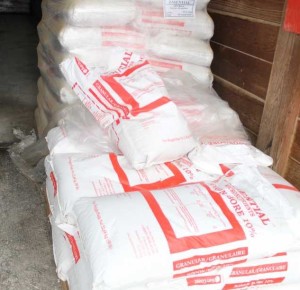2014 Micronutrients: Boron, Manganese Make Waves
With many industry insiders projecting depressed crop input demand throughout several sectors in 2014, it was somewhat surprising to witness the sheer optimism with which many micronutrient manufacturers are viewing the coming season.
“From purely a micronutrient sales perspective, we are just wrapping up our best year ever,” says Kevin Kimm, senior director of marketing, The Mosaic Co., of 2013. “And we continue to anticipate growth through the market difficulties 2014 may bring.”
There are a multitude of plausible explanations for optimism, and Jerry Stoller, president, StollerUSA, envisions growers splitting off into two distinct groups.
“One group will possess adequate capital and will invest in order to maximize income per acre. This group represents approximately 20% of domestic growers,” explains Stoller. “The second group will be those who do not have a surplus of capital. Their investment decisions will be based upon getting the maximum amount of return per dollar invested per acre.
“In my opinion, the 20% will continue to invest at a high level in order to raise corn and grain at the lowest unit production cost, and those in the 80% will tend to invest only in those items which they consider the most important to maximize profits. The former group will use micronutrients at a significantly high level and continue to have a balanced fertility program, while those of the latter group will come to restrict the use of micronutrients, as their purchases will be significantly lower than in 2012 and 2013, when grain prices were higher.”
Meanwhile, Eramet-Comilog, Inc.’s Jim Crane, agro sales and marketing manager, sees the level of enlightenment surrounding micronutrient application as the primary reason manufacturers will continue to thrive in 2014.
“Under similar conditions, I think four or five years ago people would have cut back on micros,” he says. “Now there’s more awareness around their importance, and a lot of that has to do with seed itself. A lot of these newer, high-powered hybrids demand a complete input portfolio package, so more micros are going on corn and soybeans than ever before.”
Reformulating For Success
Tom Pekarek, specialty dept. manager, United Suppliers, seconds Crane’s notion. “I think there are growers out there that do look at nutritionals as an area they can perhaps cut back on, but we very strongly discourage it,” he says. “Micronutrients are tied so closely with seed nowadays that we don’t see much of a chance for a market downturn. With today’s genetics we are very capable of producing 300 bu. corn, but if you pull back on nutritionals you won’t come anywhere close to that level of output.”
Pekarek’s outfit offers the standard full line of micronutrients, from boron to zinc, and he estimates that approximately 60% of the company’s micronutrient revenues come from granular formulations of sulfur and zinc.
“There’s just less sulfur in the atmosphere today with the restrictions on coal burning, so we’re finding most soils are in need of it,” explains Pekarek. “And zinc sulphate is just all over the board right now, it’s crazy. West of the Missouri River is a huge zinc sulphate use area, as well as sulfur.”
Pekarek also acknowledges the recent proliferation in starter and foliar-applied fertility programs having been a boon for United Suppliers.
“There’s been a large increase in starter fertilizer business, and foliar application of micronutrients has increased dramatically over the past 10 years, and we’ve seen good starter and foliar business growth around our liquid formulations,” he says. “Today foliar application of micronutrients has become almost a standard practice in corn and beans.”
Chelated zinc and manganese applications are also on the rise, he says. “There’s some really good data from Don Huber at Purdue University that shows manganese uptake is repressed by glyphosate, especially in soybeans, so at times growers using glyphosate post-emerge need to almost flood the soil with manganese to make sure enough gets into the plant.”
Looking ahead, the company Pekarek pronounces as “totally focused on our retail owners” is gearing its lineup for the coming approval of dicamba and 2,4-D traited seed. “There’s some concern, especially from the dicamba side, on not having any ammoniacal nitrogen in those tank mixtures (with glyphosate), so we’re working on reformulations to make sure our micronutrients are tank mixable with both glyphosate and dicamba, because today’s grower wants to get as many actives into that tank mix as possible.”
A Boron Bonanza
Meanwhile, The Mosaic Co. is excitedly gearing up for a spring soft launch of its newest micronutrient product, Aspire (Potassium Chloride plus Boron).

After soil testing, growers often times find boron is the second most needed micronutrient in their soils.
“Our growers are soil testing and many times they are finding boron is the second most needed micro in their soils,” says Mosaic’s Kimm. “We’re excited and our customers are excited to get their hands on the first new potash product to come out in quite a while.”
Aspire, which comes in a dry, granular formulation, was released to a select group of retailers in 2013 for hands-on evaluation. Kimm says there has been nothing but positive comments on the quality of the product.
“These products (MicroEssentials and Aspire) are considered foundational crop nutrition products in that they’re N, P and K-based, but they also allow for a more balanced crop nutrition plan,” he says.
According to Mosaic, results from Aspire research trials are in the process of being finalized and will be made available in March.
“Each time we raise the level of yield on an acre, we’re asking for our soils to be able to do more and more,” says Dr. Kyle Freeman, manager of new product development. “And now I think we’ve seen a point with the new genetics where we are, in some cases, asking more from the soil than it’s able to deliver, so we need to continue to supplement our soil with proper nutrition.”
H.J. Baker & Bros., along with its subsidiary Tiger-Sul Products, is also hawking a relatively new boron product, according to Martin Campfield, director of product management and international sales. “We did very well with our iron, manganese and zinc mixes, as well as our new boron mix, and we in fact exceeded our goals as 2013 was an outstanding year,” he says.
TIGER Boron, which Campfield describes as “breaking the barrier of boron deficiency in crop yields,” is registered in all 50 states for the coming season.
“Boron deficiency has been described as ‘a more extensive deficiency than of any other plant micronutrient’ and fixing the problem has been challenging for producers,” explains Campfield of why so many new boron products are coming to market.
TIGER Magnesium 15% is also new for this season. “TIGER Magnesium contains a finely balanced trio of bentonite clay, sulfur and magnesium in oxide form. This unique blend of sulfur and magnesium uses the acid released from the sulfur oxidation process to convert magnesium to a plant-available form throughout the growing season,” says Campfield. “TIGER Magnesium can also be used safely and effectively in starter fertilizer and on sensitive specialty crops, since it has a low salt index.”
Manganese Making Headway
At Erachem-Comilog, an international manufacturer of manganese fertilizer products with domestic operations based in Baltimore, MD, Tecmangam (manganese sulfate monohydrate) is enjoying its title as the “top manganese fertilizer product” in the market, according to the company’s Crane.
“The product is 100% water soluble (as opposed to oxysulfate formulations), so it’s easily taken up by the plant, it can be foliar-applied or broadcast and it’s great on GMO-soybeans to counter yellow flash,” says Crane. “When you treat glyphosate-tolerant beans they can stress and turn yellow. Following up that glyphosate application with a Tecmangam foliar application will green those beans up real well.”
While it is still up for debate in some circles, Crane says recent Purdue University research indicates up to a 12 bushels per acre yield loss via yellow flash.
“Tecmangam is well-entrenched, so much so that many growers looking for any manganese product will go to their retailer and say ‘I want Tecmangam’, so it’s become a well-known brand name” Crane adds.
Additionally, Erachem-Comilog markets a variety of other manganese products, from manganese oxide and manganese carbonate to manganese nitrate. According to Crane, various Chelate manufacturers purchase raw-form manganese from Erachem to formulate into their own proprietary products, as well.
WinField Solutions, meanwhile, saw soild engagment from retailers and growers of its MAX-IN line of micros, according to Mark Heineman, WinField plant nutrition specialist.
“Our MAX-IN lineup was successful being sprayed on several crops that via NutriSolutions tissue sampling identified a micronutrient application need,” he says. “MAX-IN foliar products have shown great return on investment when the demand is needed, and timing and application rates have remained the same.”
According to Heineman, a new product available for this year is MAX-IN Zinc.
Additionally, WinField continues to tout its NutriSolutions 360 program, which Heineman describes as “a multi-dimensional approach using soil, resin, and tissue sampling to provide critical agronomic insights.”
“In 2013 we focused on potassium since it was the most common limiting nutrient over crops and areas,” says Heineman. “Our data to insights team is currently processing the information from the first year of NutriSolutions 360 and working to provide manageable information for our retailers and growers to implement. NutriVision sampling was also a new component under the NutriSolutions 360 System in 2013.”
At Wolf Trax, 2013 sales figures termed robust, driven by increasing international demand have the Canadian-based plant nutrient manufacturer poised for an eventful 2014 growing season.
“We’ve experienced double digit growth in almost all products in all territories,” says Kerry Green, managing direrctor. “And we continue to see strong demand for Zinc DDP and Boron DDP as corn growers strive for 300 bushel yields.”
Green says the company is readying for a 2014 product launch of Nu-Trax P+, which he describes as “a revolutionary product.”
Designed to address a number of challenges with traditional phosphorus application, Nu-Trax P+ features a more effective nutrient package for early plant growth (P, Zinc and Manganese) compared to traditional granular phosphate fertilizers applied at planting time, according to Green. The product also features Wolf Trax’s EvenCoat Technology.
“Nu-Trax P+ can be applied as a fertilizer coating on dry fertilizer, and can potentially replace or augment the granular phosphate in a fertilizer blend,” Green says. “We think Nu-Trax P+ has the potential to re-shape the phosphorus fertilizer segment.”
In addition, Green says that pre-commercialization work is wrapping up on a new soluble zinc product, which will be the first in a family of patent-pending fully soluble nutrients from Wolf Trax.
“These products are designed to promote better absorption into the leaf and enhance translocation through the plant,” he says. “Tentatively called LeafSorb Technology, this feature will enable growers to reduce the number of sprays they currently need to deliver zinc to new growth.”
Green says the new soluble zinc formulation will be of special interest to the fruit and specialty vegetable markets, as well as nut growers, who he says all know the challenges of delivering zinc in a useable form to the plant.
In addition to Nu-Trax P+ and the soluble zinc product to be launched in 2014, according to Green Wolf Trax anticipates adding to the soluble family of nutrients with highly soluble copper and iron products. These nutrients will also feature patent-pending LeafSorb Technology, and Wolf Trax may look to add to the Nu-Trax family of products and expand our seed-applied nutrient product line as well.






